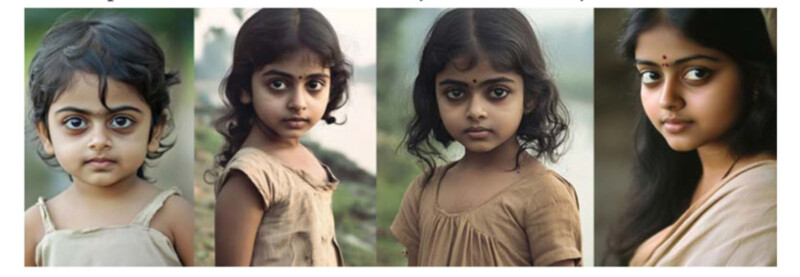How a Photojournalist Used Generative AI to Illustrate a Classic Story
![]()
In Bengali culture, Subha is a short story of a mute girl written in 1892 by the first Asian to win the Nobel Prize in Literature, Rabindranath Tagore.
“There are very few, almost no previous visual references or illustrations of the story of Subha,” says former news photographer Sankha Kar. “Subha existed mostly in written form.”
Kar, now a Knight Fellow pursuing a master’s degree in the United States, set out to create images to illustrate this classic tale of a mute village girl who expresses herself with her eyes and gestures.
Global stock databases, Kar discovered, under-represent unique cultural, ethnic, and regional elements of identity. He says that faces generated by artificial intelligence (AI) tend to be “Western-looking” or generic.
Kar shares how he researched the Subha story to fine-tune AI prompts for the sake of cultural accuracy. His process, he says, could have widespread application in visualizing children’s stories, folk tales, and classic literature worldwide.
“My quest,” says Kar, “has been to create characters that are as authentic as possible, similar to the way Oscar-winning period films meticulously reconstruct historical accuracy in their visuals.”
Who is Sankha Kar?
A self-described “hardcore photographer,” Kar has worked for news publications in India and United Arab Emirates and freelanced for Reuters.

For the 2024-25 academic year, he was awarded a fellowship at Ohio University supported by the John S. And James L. Knight Foundation providing full tuition plus stipend.
On March 21, Kar submitted his master’s project to a three-person academic committee comprised of internationally acclaimed author/designer Adonis Durado and visual journalists Josh Birnbaum and Terrance Reimer.
“I haven’t come across any other master’s projects in applied generative AI within higher education,” says Associate Professor Durado.
Kar is from the West Bengal region of India, the setting of the Tagore’s Subha short story. A Nobel Prize winner in 1913, Tagore’s work is taught in schools and celebrated in festivals, music, and theater.
Research to Guide AI
To learn about the clothing and physical features of Bengali people of the late 19th Century and their village settings, Kar studied:
- Photographs from the colonial period including the work of British banker-turned-photographer Samual Bourne (1834-1912) who sailed to India in 1863. “These images helped me visualize the houses, boats, landscapes, and everyday life of that era,” Kar says.
- Old paintings, photographs, and illustrations at the U.S. Library of Congress and National Archives of India.
- Films by Bengali director Satyajit Ray, who received an honorary Oscar in 1992 for lifetime achievement.
- Online Bengali heritage collections depicting traditional attire, jewelry, marriage rituals, and village life.
Prompting AI
Armed with archival research — and personal knowledge of his home region in India — Kar manually guided generative AI tools Midjourney and Adobe Firefly to visualize the Subha story.
Prompts were detailed:
![]()
![]()
The Big Picture
The current marketplace offers multiple AI tools for book publishing, illustrations, and cover art.
The Guardian published an opinion piece on December 26, 2023, with this headline: “I was shocked: my husband was using AI to write our children’s bedtime stories.”
But Kar found inadequate AI depictions of Bengali landscapes, facial features, attire, and more.
“I found that Midjourney and Adobe Firefly struggled to accurately generate 19th Century Bengali attire,” he says. “When I described modern clothes styles, the AI handled them with much more ease, highlighting a clear bias in training data toward contemporary fashion references.”
Over time, generative artificial intelligence will improve its ability to portray cultural nuances and classic stories, Kar predicts.
“In the future, AI may require less manual guidance to create culturally authentic visuals. This progression depends on projects like mine today,” he says. “This is not a flaw of the technology, but a natural step in its maturation.”
Offering his roadmap to enhance historical accuracy in generative AI storytelling and illustration, Kar hears echoes of an old debate about the purity of artistic expression versus new technology.
He recalls the dire prediction of French painter Paul Delaroche in 1840 who was alarmed by the introduction of photography: “From today, painting is dead.”
Kar ponders the current debate about generative AI and photography, saying, “Photography didn’t kill painting. It expanded the visual language.”
“History teaches us that every new tool initially threatens tradition but also holds the potential to redefine it.”

For his part, Kar wants to use generative AI to show the world an accurate visualization of a mute Bengali girl Subha, who finds ways to express herself without saying a word.
strong>Image credits: Sankha Kar
About the author: Ken Klein lives in Silver Spring, Maryland; he is retired after a career in politics, lobbying, and media including The Associated Press and Gannett in Florida. Klein is an alumnus of Ohio University and a member of the Dean’s Advisory Council of the Scripps College of Communication. Professionally, he has worked for Fort Myers News-Press (Gannett), The Associated Press (Tallahassee), Senator Bob Graham, and the Outdoor Advertising Association of America (OAAA).